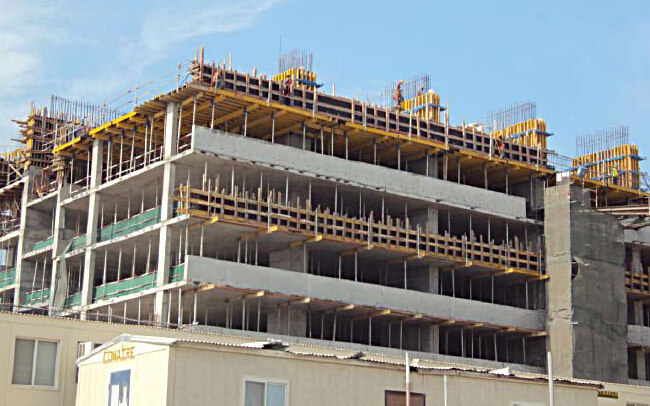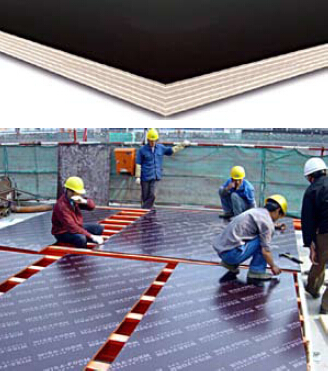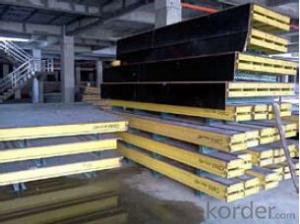Plywood formwork system for formwork and scaffolding
- Loading Port:
- Tianjin
- Payment Terms:
- TT OR LC
- Min Order Qty:
- 50 m²
- Supply Capability:
- 1000 m²/month
OKorder Service Pledge
Quality Product, Order Online Tracking, Timely Delivery
OKorder Financial Service
Credit Rating, Credit Services, Credit Purchasing
You Might Also Like
Plywood --- make perfect concrete surface
WISA-Form Birch is a coated special plywood using in the formwork systems where high
requirements are set on the concrete surface and the times of reuses.
With CNBM timber beam & WISA plywood, the formwork is low weight but high load capacity, it is
widely used in construction.
Characteristics:
◆ Component with high standardization.
◆ Assembling in site, flexible application.
◆ Light weight, easy transportation and storage.


- Q:What are the factors to consider when selecting steel formwork?
- When selecting steel formwork, there are several important factors to consider. These include the project requirements, such as the size and complexity of the structure, the desired finish, and the required strength and durability. Other factors include the cost-effectiveness of the formwork system, the ease of assembly and disassembly, and the availability and accessibility of the formwork supplier. Additionally, it is crucial to consider the load-bearing capacity and stability of the steel formwork, as well as its compatibility with other construction materials and techniques.
- Q:How does steel formwork affect the overall acoustic properties of the structure?
- The overall acoustic properties of a structure are not significantly affected by steel formwork. Steel formwork refers to temporary structures made of steel panels that are used to hold concrete in place during construction. Once the concrete has hardened, these formwork systems are typically removed. The materials used in permanent construction elements, such as walls, floors, and ceilings, primarily determine the acoustic properties of a structure. Since steel formwork is not a permanent part of the structure, it does not contribute to its acoustic properties. However, it is important to acknowledge that steel formwork can create temporary noise and vibrations during the construction process. This is due to the handling of the steel panels and the pouring and compacting of concrete. These construction activities can generate noise that may affect the acoustic environment near the construction site. However, once the formwork is removed and the structure is finished, the steel formwork itself does not have a significant impact on the overall acoustic properties of the building.
- Q:How does steel formwork handle different concrete jointing techniques?
- Steel formwork is a versatile and robust material that can easily handle different concrete jointing techniques. Whether it is used for traditional jointing methods like keyways, tongue and groove, or dowels, or for more advanced techniques like construction joints, expansion joints, or control joints, steel formwork provides the necessary strength and stability to ensure the jointing process is successful. Its durability allows it to withstand the pressure and forces exerted during the concrete pouring and curing stages, ensuring that the joints remain intact and the structure maintains its integrity. Additionally, steel formwork can be easily customized and adjusted to accommodate various jointing requirements, making it a reliable choice in construction projects.
- Q:Can steel formwork be used for precast concrete arches?
- Yes, steel formwork can be used for precast concrete arches. Steel formwork is a versatile and durable material that can be used to create complex shapes and structures, including arches. Steel formwork provides excellent support and stability during the casting process, allowing for the precise and accurate formation of arches. Additionally, steel formwork can be easily customized and adjusted to accommodate different arch designs and dimensions. Its strength and rigidity make it suitable for withstanding the pressure and weight of the concrete during the curing process. Therefore, steel formwork is a preferred choice for constructing precast concrete arches due to its flexibility, strength, and reliability.
- Q:How is steel formwork supported during concrete pouring?
- Steel formwork is supported during concrete pouring through a system of props, beams, and scaffolding. Props are vertical supports that are strategically placed beneath the steel formwork to provide stability and prevent any sagging or collapsing under the weight of the wet concrete. These props are typically adjustable, allowing for precise positioning and leveling of the formwork. In addition to props, horizontal beams are used to provide further support to the steel formwork. These beams are usually placed at regular intervals and are connected to the props, creating a sturdy framework that can withstand the pressure exerted by the concrete. The beams also help distribute the load evenly across the formwork, ensuring that it remains balanced and secure. Scaffolding is another crucial component in supporting steel formwork during concrete pouring. It is erected around the formwork to provide a safe working platform for workers to access and maneuver the formwork. Scaffolding also assists in the installation and removal of the formwork, enabling efficient construction processes. Overall, the combination of props, beams, and scaffolding plays a vital role in supporting steel formwork during concrete pouring. This support system ensures that the formwork remains stable, allowing the concrete to be poured and cured accurately, resulting in a strong and durable structure.
- Q:Can steel formwork be used in areas with high seismic vulnerability?
- Certainly! Steel formwork is capable of being utilized in regions with a notable susceptibility to seismic activity. Due to its remarkable strength and durability, steel formwork is well-suited for enduring seismic forces. This inflexible system is capable of withstanding both horizontal loads and vibrations induced by earthquakes. Furthermore, steel formwork can be readily reinforced to heighten its resistance to seismic activity. Nevertheless, it is vital to ensure that proper engineering and design considerations are taken into account in order to effectively anchor and brace the formwork system, allowing it to withstand the specific seismic conditions of the area. In summary, steel formwork presents itself as a feasible choice for construction in regions with high seismic vulnerability; however, it is imperative to exercise appropriate precautions and implement design modifications to guarantee its efficacy.
- Q:How does steel formwork handle concrete flowability and workability?
- Steel formwork is highly effective in handling concrete flowability and workability due to its durable and rigid nature. When concrete is poured into steel formwork, it easily conforms to the desired shape, resulting in a smooth and even finish. The steel formwork provides excellent support and stability, preventing any deformation or movement during the pouring and curing process. Steel formwork is designed to withstand the pressure exerted by the concrete, ensuring that it can handle any flowability variations. The formwork's tight joints and smooth surfaces allow for better control of the concrete's flow, preventing any leakage or seepage. This enables the concrete to be placed precisely and evenly, ensuring a consistent quality throughout the structure. Moreover, steel formwork is highly adaptable, allowing for easy adjustments and modifications to accommodate changes in concrete flowability and workability. The formwork can be easily assembled, disassembled, and repositioned as needed, providing flexibility in construction projects. Additionally, steel formwork offers a high level of reusability. Its durability and resistance to wear and tear make it suitable for multiple concrete placements, reducing overall construction costs and environmental impact. In summary, steel formwork effectively handles concrete flowability and workability by providing a stable and rigid structure that supports the concrete during placement and curing. Its adaptability, durability, and reusability make it a preferred choice in construction projects where precise and consistent concrete finishing is desired.
- Q:How does steel formwork handle concrete curing additives?
- Steel formwork is a popular choice for concrete construction due to its durability and strength. When it comes to handling concrete curing additives, steel formwork is highly compatible and can effectively accommodate the use of such additives. Concrete curing additives, such as accelerators or retarders, are used to modify the setting and hardening time of concrete. These additives are typically added to the concrete mixture during the mixing process or applied to the surface of the formwork before pouring the concrete. Steel formwork is not adversely affected by the presence of curing additives in the concrete. It is resistant to chemical reactions and can withstand the potentially corrosive nature of certain additives. This ensures that the steel formwork remains structurally sound and maintains its integrity throughout the concrete curing process. Furthermore, steel formwork offers a smooth and non-porous surface, which allows for easy application and penetration of curing additives. This facilitates the even distribution of additives across the concrete surface, promoting consistent curing and optimal strength development. Moreover, steel formwork is reusable, which means that it can be used for multiple concrete pours. This reusability factor is particularly advantageous when working with concrete curing additives, as the formwork can be easily cleaned after each use, ensuring that no residue or build-up of additives remains on the surface. This helps to prevent any potential interference with subsequent concrete pours or compromising the quality of the cured concrete. In summary, steel formwork is well-suited for handling concrete curing additives. Its chemical resistance, smooth surface, and reusability make it an ideal choice for accommodating the use of curing additives, ensuring efficient and effective concrete curing.
- Q:Can steel formwork be used for both straight and curved concrete elements?
- Steel formwork is suitable for both straight and curved concrete elements. Its versatility allows for easy adjustment and shaping to meet various design needs. With its excellent strength and durability, steel formwork is perfect for constructing both straight and curved elements. Its flexibility allows for the creation of complex shapes, making it ideal for projects that require curved elements like architectural features, curved walls, or circular structures. Furthermore, steel formwork ensures a smooth and uniform surface finish, guaranteeing high-quality concrete results for both straight and curved elements.
- Q:How does steel formwork affect the overall productivity of the construction process?
- Steel formwork can have a significant impact on the overall productivity of the construction process. Firstly, steel formwork is known for its durability and strength, allowing it to withstand the high pressures and forces exerted by concrete during the pouring and curing stages. This durability ensures that the formwork remains intact and stable, reducing the need for repairs or replacements, thus saving time and cost. Moreover, steel formwork offers increased efficiency in terms of assembly and disassembly. Steel panels can be easily connected and detached, allowing for quick and smooth installation and removal. This ease of use ensures that the construction process can progress at a faster pace, increasing overall productivity. Additionally, steel formwork provides a smooth and high-quality finish to concrete structures. The precise and rigid nature of steel formwork prevents any deformations or warping during the pouring and curing stages, resulting in a superior surface finish. This eliminates the need for additional finishing work, such as plastering or smoothing, thereby reducing the time and effort required for post-construction tasks. Furthermore, steel formwork is highly adaptable and can be customized to fit various shapes and sizes, enabling the construction of complex structures with ease. This flexibility allows for greater design freedom and eliminates the need for additional supporting structures, reducing construction time and increasing productivity. Lastly, steel formwork is reusable and can be used for multiple projects, unlike traditional timber formwork which often needs to be discarded after a single use. This reusability not only reduces material waste but also saves time and cost in procuring new formwork for each project. In conclusion, steel formwork significantly enhances the overall productivity of the construction process. Its durability, ease of assembly, high-quality finish, adaptability, and reusability all contribute to faster construction timelines, reduced costs, and improved efficiency, making it a preferred choice for many construction projects.
1. Manufacturer Overview |
|
|---|---|
| Location | |
| Year Established | |
| Annual Output Value | |
| Main Markets | |
| Company Certifications | |
2. Manufacturer Certificates |
|
|---|---|
| a) Certification Name | |
| Range | |
| Reference | |
| Validity Period | |
3. Manufacturer Capability |
|
|---|---|
| a)Trade Capacity | |
| Nearest Port | |
| Export Percentage | |
| No.of Employees in Trade Department | |
| Language Spoken: | |
| b)Factory Information | |
| Factory Size: | |
| No. of Production Lines | |
| Contract Manufacturing | |
| Product Price Range | |
Send your message to us
Plywood formwork system for formwork and scaffolding
- Loading Port:
- Tianjin
- Payment Terms:
- TT OR LC
- Min Order Qty:
- 50 m²
- Supply Capability:
- 1000 m²/month
OKorder Service Pledge
Quality Product, Order Online Tracking, Timely Delivery
OKorder Financial Service
Credit Rating, Credit Services, Credit Purchasing
Similar products
New products
Hot products
Related keywords

























